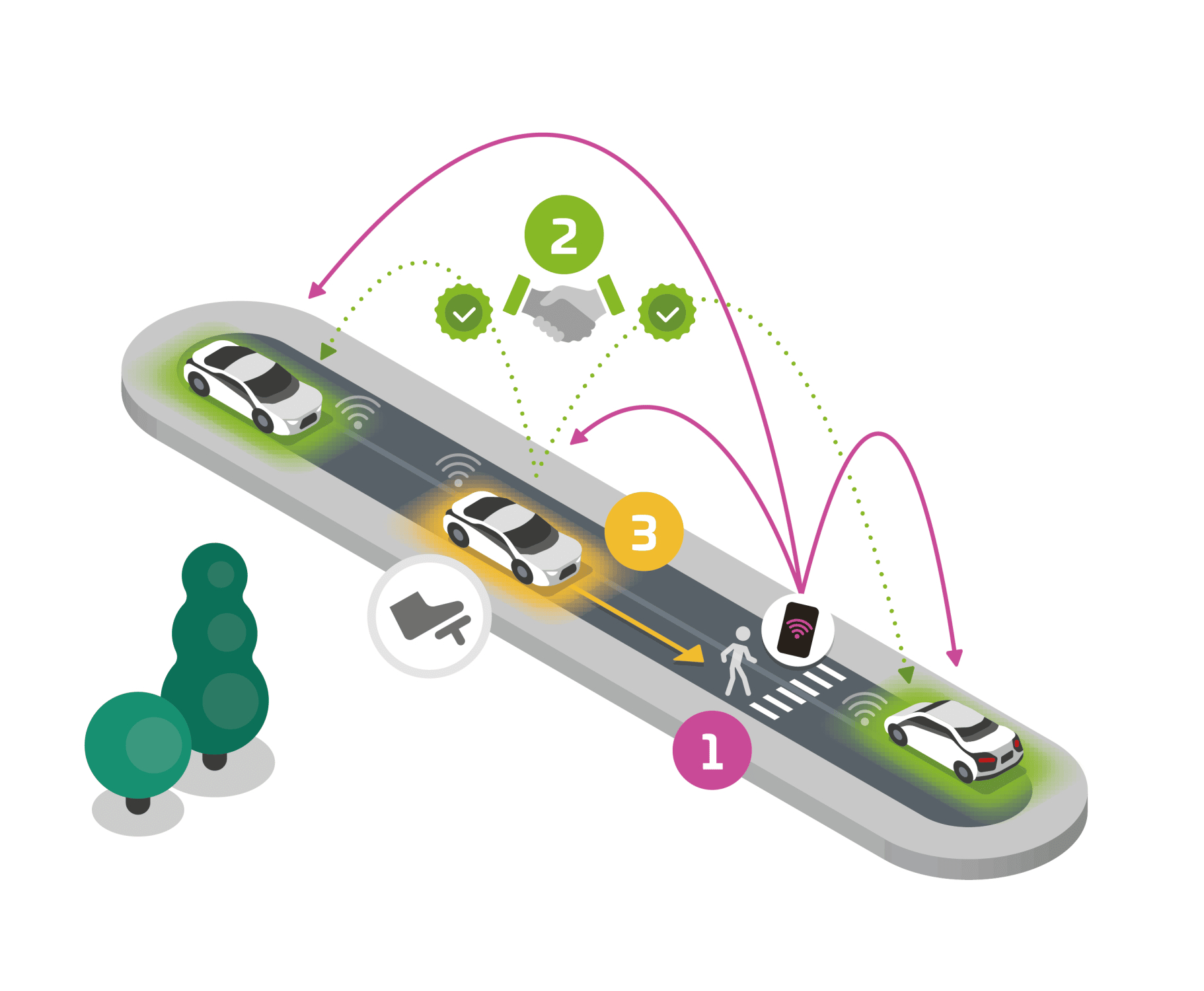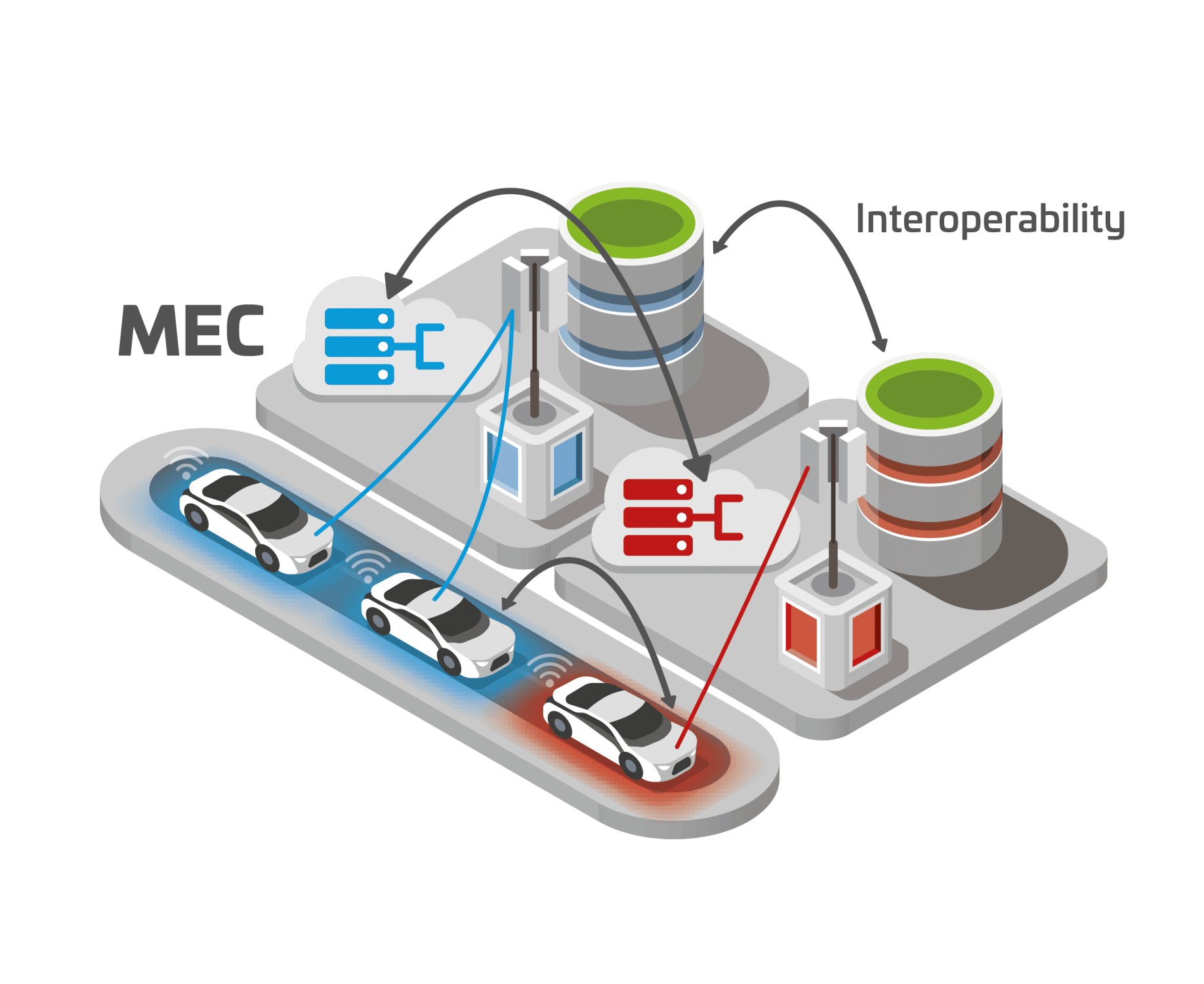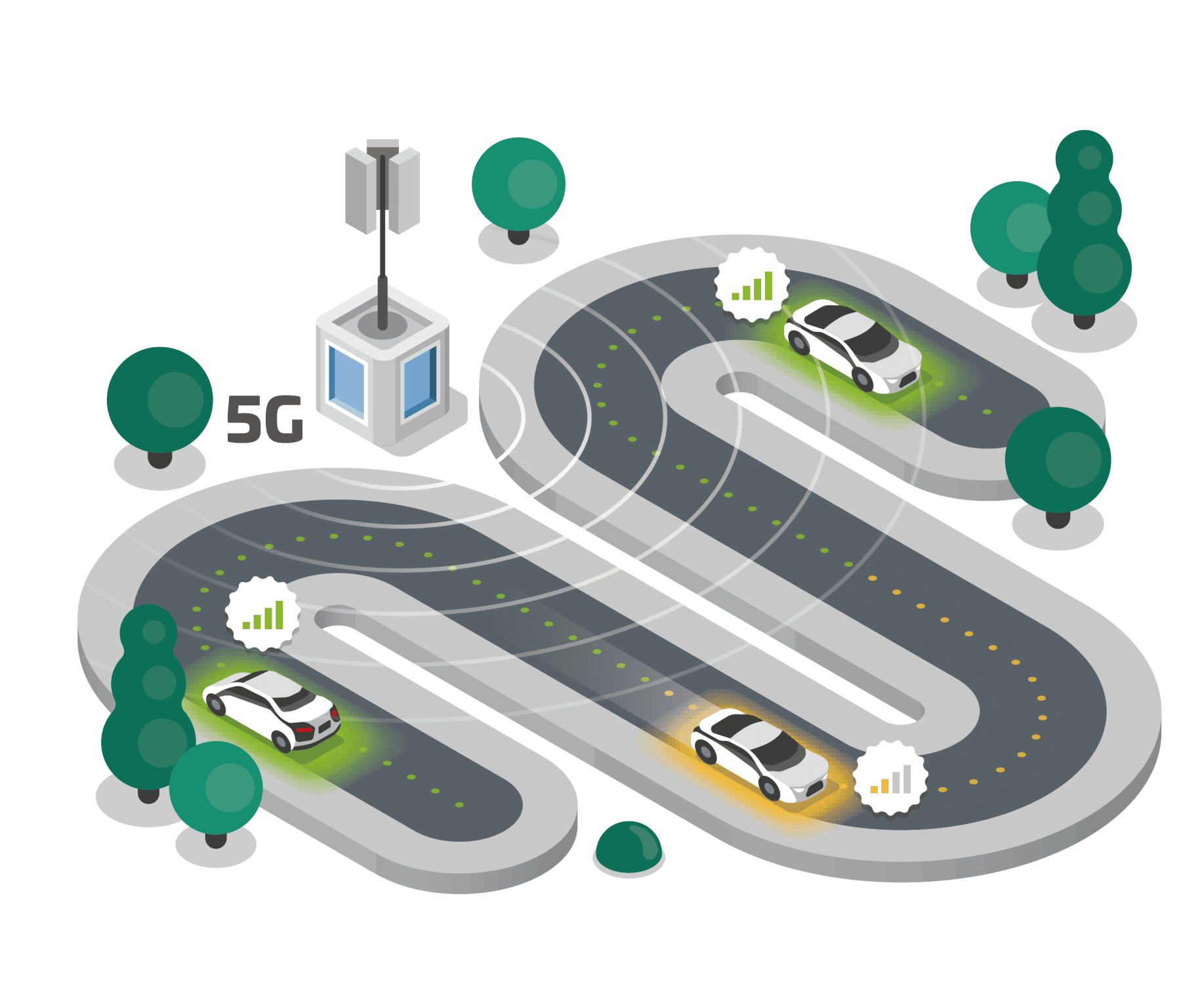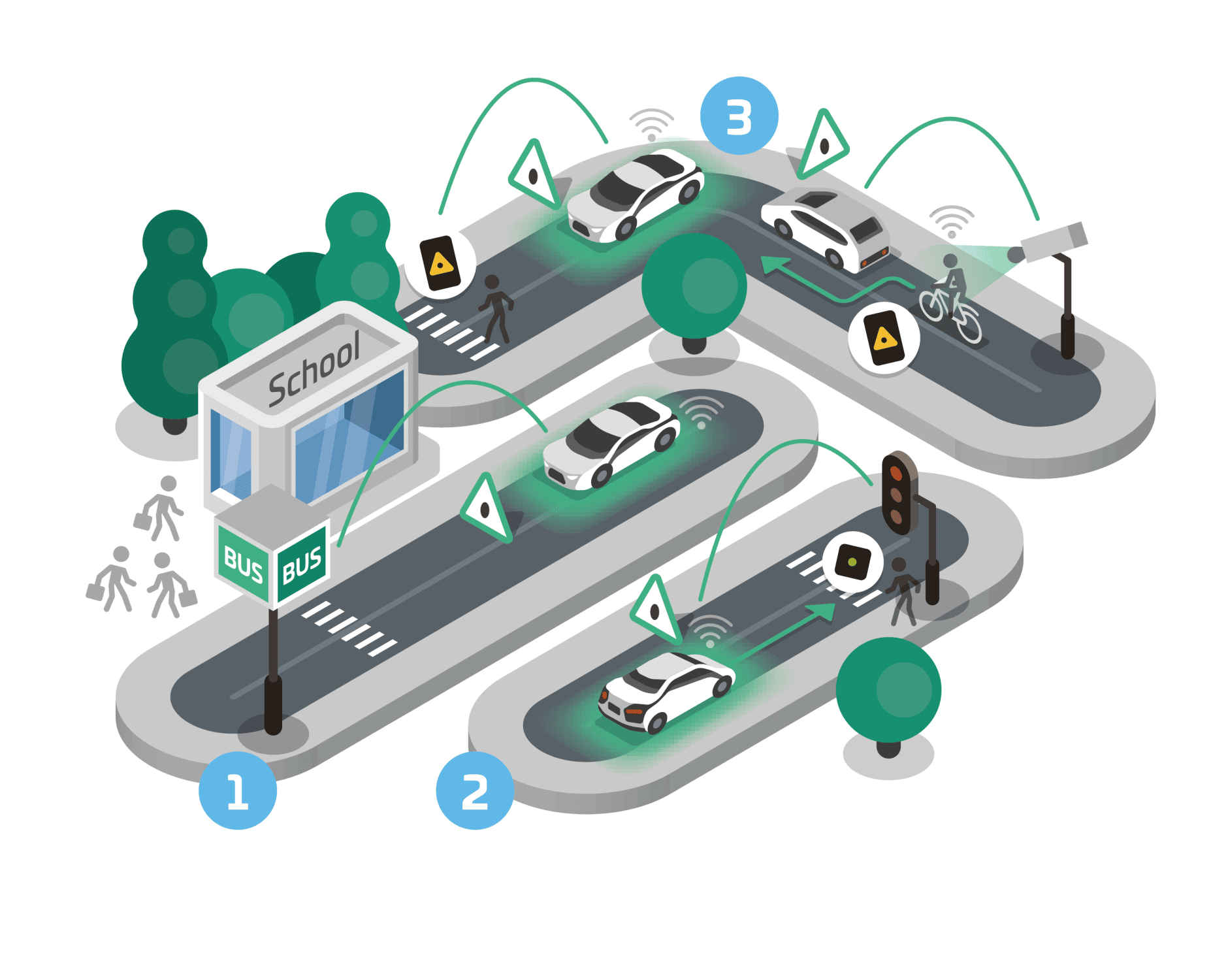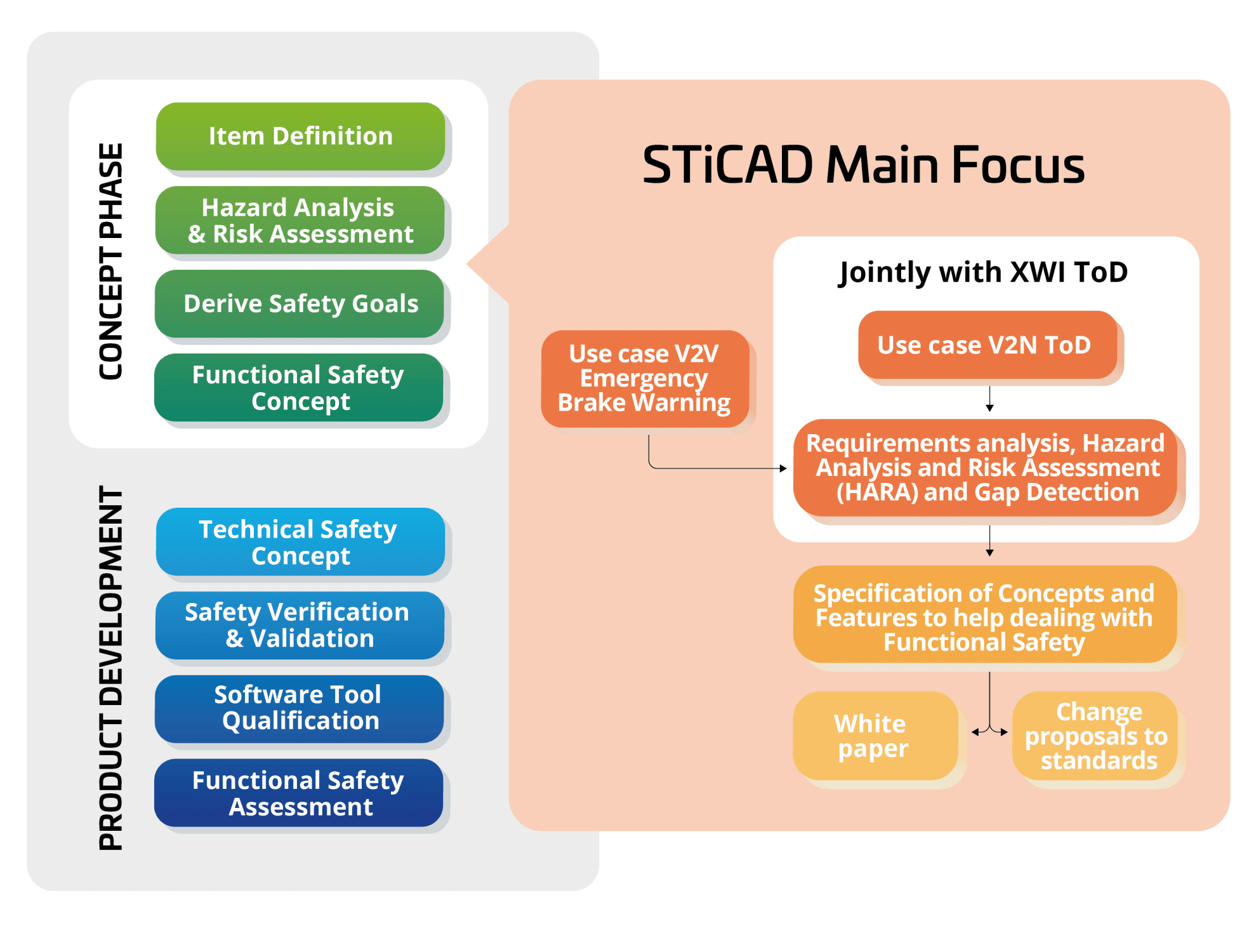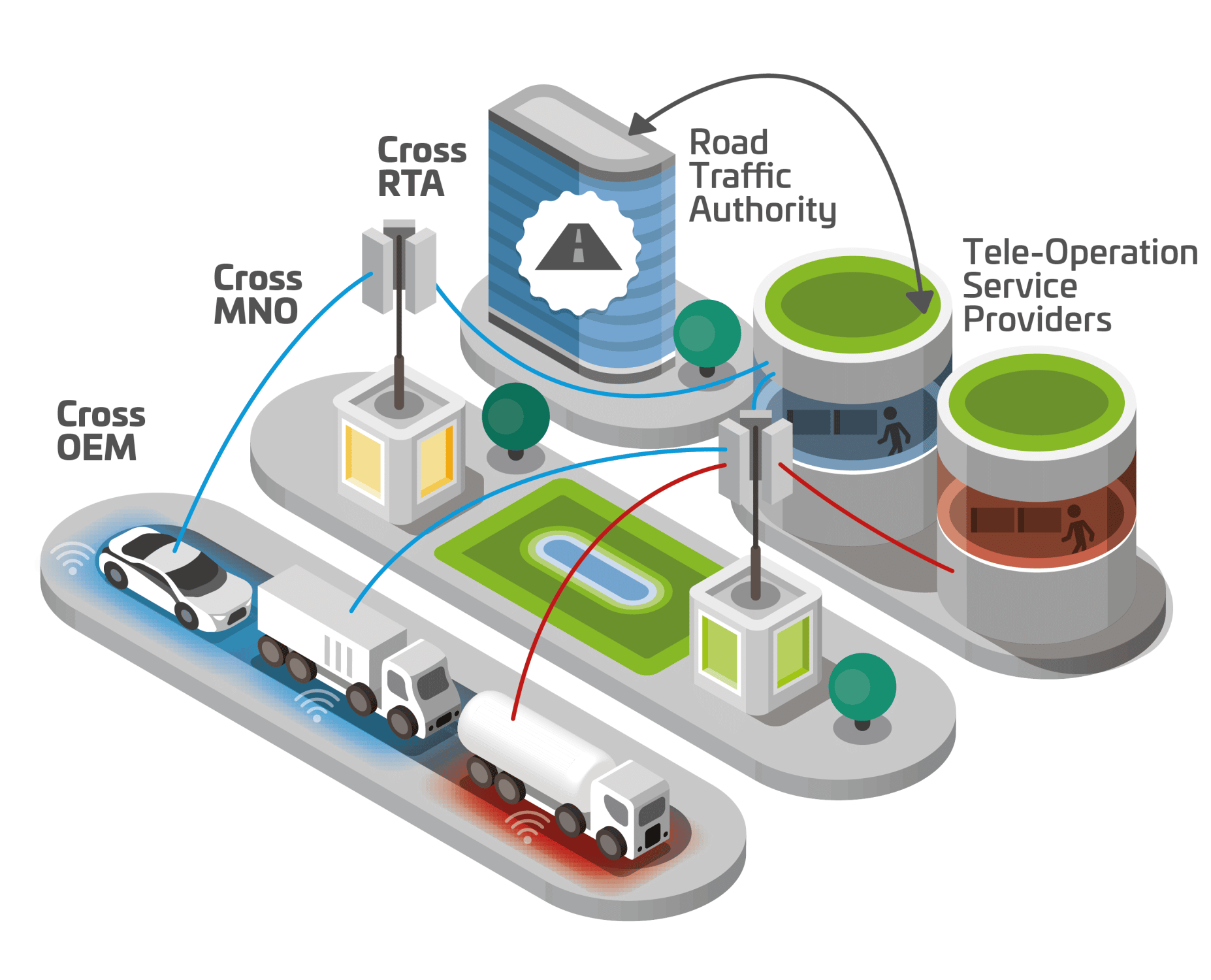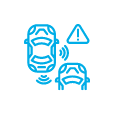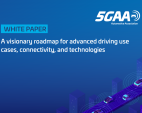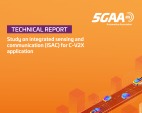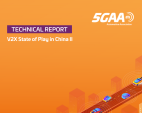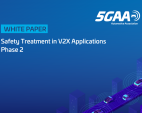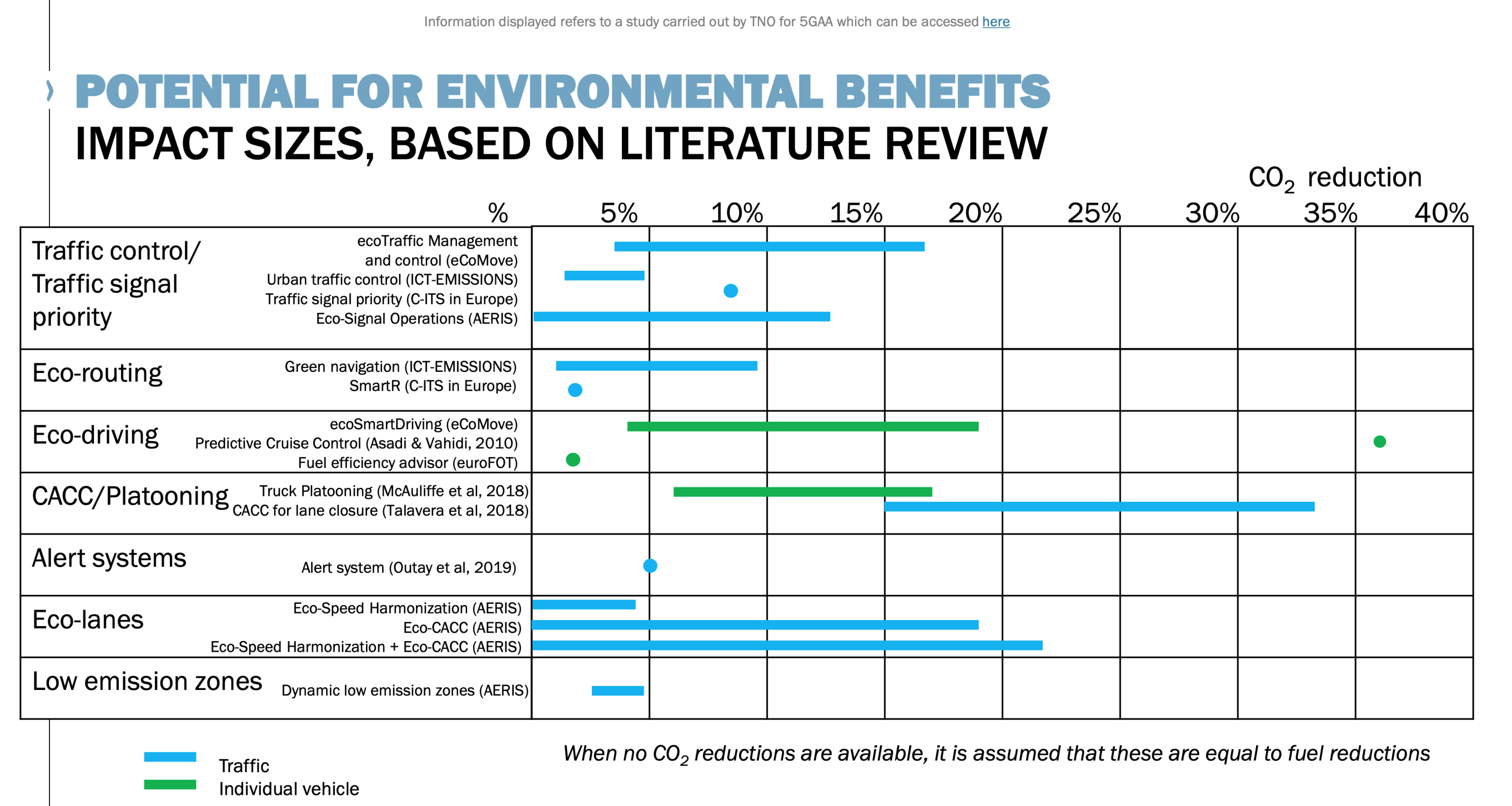
C-V2X continues to drive the automotive transformation and is now the new reality
These past years have seen revolutionising digital transformations and challenging innovative mobility solutions. 5GAA keeps on shaping the new era of mobility and paves the way towards connected driving.
As individuals, in teams, and together with our members, we have embraced digital transformations as opportunities for transportation innovations. Today, we celebrate five years of intense activities, global cooperation, partnerships and demonstrations that resulted in remarkable achievements.
Our purpose is to develop end-to-end solutions for future mobility and transportation services for road safety, improved traffic efficiency, sustainable impact and more comfortable driving. While our purpose is not new, it is more relevant than ever. It reminds us that 5GAA exists to ensure future generations’ wellbeing in a safe and sustainable transportation ecosystem.
For five years, our vision has been guiding the association, gathering eight early co-founding members with the same ambition, and quickly bringing together more than 110 members from the automotive, technology, and telecommunications industry. This rapid expansion generated a genuinely global platform and connected community for cross-industry cooperation.
Members include 13 of the top fifteen global automakers and 9 of the top ten global mobile network operators. The exponential geographical reach of the association allows 5GAA to exert some influence on the connected driving stage. 5GAA is seen as a leader and enabler at a global level. It has successfully established C-V2X (cellular vehicle-to-everything) and 5G as the technology of choice in the market through numerous partnerships, bringing the expertise of manufacturers to develop 360-degree solutions for safer and more sustainable mobility. Thanks to these partnerships, 5GAA has established more than mobile broadband connectivity, integrating the multiple facets of connected mobility such as interoperability and standardisation.
People bring our purpose and vision to life. We have taken the future of mobility to a new level these past years, accelerating research and organising live demonstrations worldwide, which focused on interoperability tests. The Shanghai, Washington, Paris, Berlin and Turin demonstrations prove that a connected ecosystem holds the unlimited possibilities of investing in C-V2X and 5G. I also take this opportunity to thank our members for their hospitality and for showcasing these crucial innovations’ outstanding performance.
We have continued to stand firm on our purpose throughout the years, regularly positioning the association and sharing our members’ concerns with institutional bodies. Even though a set of challenges remains to be resolved, we hope to keep seamless exchanges with the institutional actors to unleash the potential of a connected ecosystem.
Today, I am proud to be part of an innovative and ambitious association that strives for a better future as it bridges cultural and technical differences. In this 5th-anniversary special publication, we have gathered some of the greatest stories of impact and success in relation to C-V2X in some regions, such as China and the US, as well as insightful interviews.

Connected mobility
5G-V2X onward
5G technologies are the next generation of wireless networks. It is key to transmitting more extensive amounts of data more reliably, with lower latency and at faster speeds than ever before.
C-V2X is the next generation telematics that can support new automotive deployments and build a new transportation ecosystem for the future.
The C-V2X technology is already available but to support the autonomous vehicles of tomorrow, the technology must evolve to meet more demanding safety requirements. 5G will facilitate this evolution. Its extreme throughput, low latency, and enhanced reliability will allow vehicles to share rich, real-time data, supporting fully autonomous driving experiences.
The 5G Automotive Association (5GAA) is shaping the path to 5G by supporting C-V2X, as well as working to deliver innovations in on-device intelligence and integration in connected vehicles. The 5GAA is confident that a technically superior standards-based cost-effective and scalable access technology from the cellular industry will carry C-ITS and Connected Vehicle applications well into the 5G era and beyond.
Supporting Innovation: C-V2X Use Cases
Under its current Work Programme, 5GAA seeks to leverage today and tomorrow’s innovative C-V2X solutions
for a safer, greener and more efficient transportation system, benefiting all road users.
Our Roadmap for Advanced Driving Use Cases and Connectivity Technologies
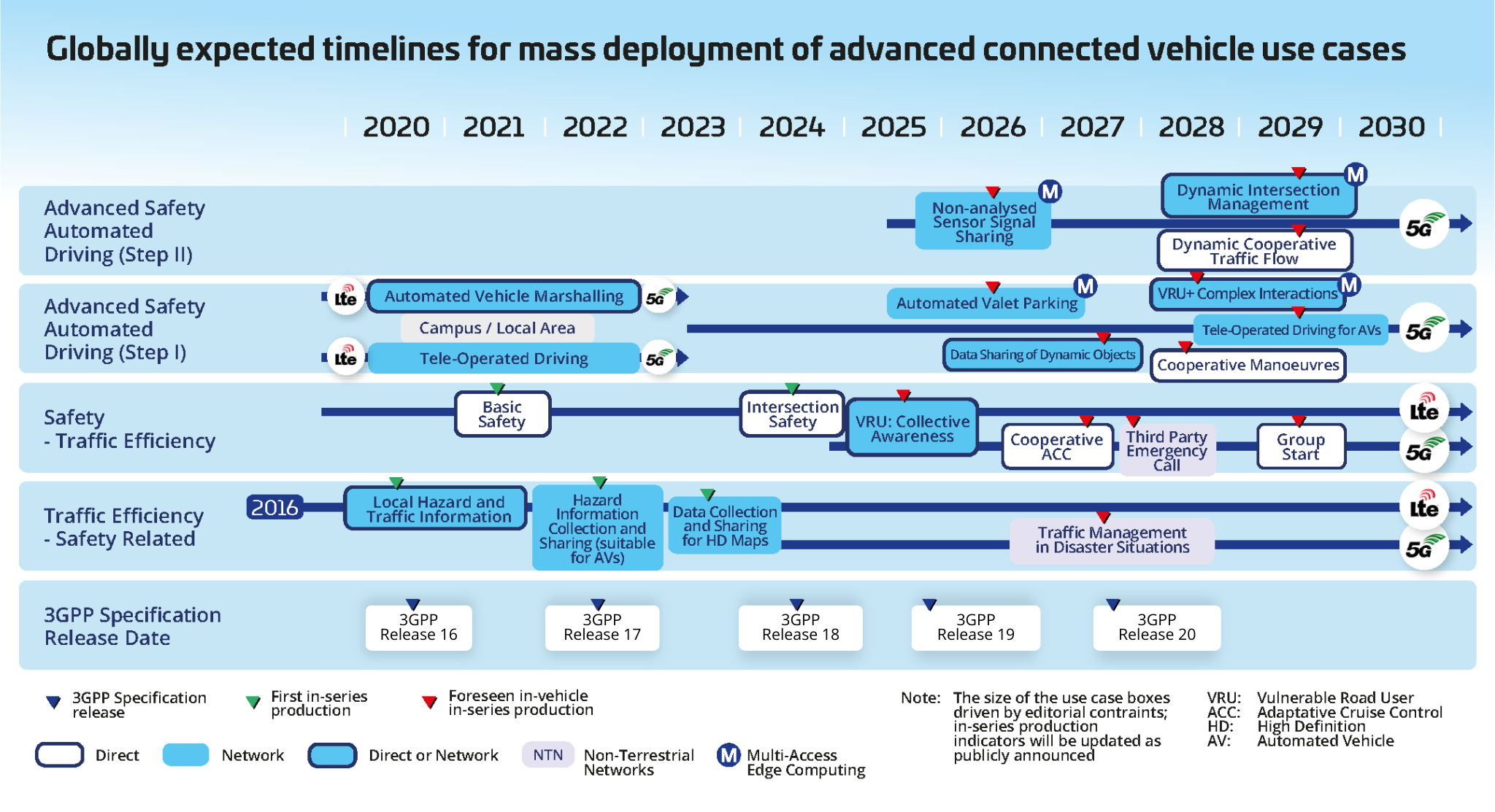

About us
Connected Mobility for People, Vehicles and Transport Infrastructure
The 5G Automotive Association (5GAA) is a global, cross-industry organisation of companies from the automotive, technology, and telecommunications industries (ICT), working together to develop end-to-end solutions for future mobility and transportation services. Created in September 2016, 5GAA has rapidly expanded to include key players with a global footprint in the automotive, technology and telecommunications industries. This includes automotive manufacturers, tier-1 suppliers, chipset/communication system providers, mobile operators and infrastructure vendors.

5GAA was created to connect the telecom industry and vehicle manufacturers to develop end-to-end solutions for future mobility and transportation services.
Mission
5GAA bridges the automotive and telecommunication industries in order to address society’s connected mobility needs, bringing inclusive access to smarter, safer and environmentally sustainable services and solutions, integrated into intelligent road transportation and traffic management.
A visionary roadmap

What we do
5GAA is addressing today’s mobility key challenges. With C-V2X technology, 5GAA will revolutionise the mobility ecosystem and the way drivers interact with the world. 5GAA’s ambition is to improve the overall transportation industry to make it safer, greener and more efficient for vehicles, road users and the surrounding infrastructure.

5GAA has defined 4 strategic pillars designing the short and long term goals in very diverse domains contributing to the same ambition: Connected Mobility.

Connected Mobility
Sustainability
Sustainability benefits of C-V2X
Cellular Vehicle-to-Everything, or C-V2X, communications will make transportation not only safer and smarter but also more sustainable.
Sustainability has three dimensions: environmental, social and economic.
C-V2X ticks all three boxes:
- Environmental: By helping to make every trip smarter, safer and more efficient, C-V2X helps reduce congestion and accidents, thereby reducing air pollution, noise pollution and energy use.
- Social: Saving lives and avoiding injuries are clear social benefits. By enabling real-time communication between pedestrians, cyclists, traffic infrastructure and moving vehicles, including motorcycles and electric scooters, C-V2X will help avoid accidents that otherwise would result in injuries and deaths.
- Economic: By enabling more efficient mobility, C-V2X will save people and employers billions of man-hours currently wasted in traffic jams. Those man-hours can then be dedicated to more rewarding activities.
C-V2X also enables the growth of autonomous mobility, which in turn offers even greater sustainability benefits, for example mobility-as-a-service offerings.
To learn more, watch the short video or scroll down for more details.
C-V2X and Sustainability in detail
ENVIRONMENTAL BENEFITS

- Transport still represents about 25% of Europe’s total CO2 emissions. By helping to make every trip smarter, safer and more efficient, C-V2X helpsreduce congestion and accidents, thereby reducing energy use, noise pollution and air pollution.
- C-V2X can help all vehicles operate and deliver people and goods more efficiently, thereby reducing pollution and optimizing the use of valuable energy resources.
- INRIX calculated that each second of reduced delays at traffic signals across the United States would translate to an annual reduction of 800,000 metric tons of CO2.
- Connected vehicle technology can help electric cars calculate an energy-optimised route to a charging station that’s not necessarily the fastest or nearest but requires the least energy to reach.
- Examples of environmental benefits enabled by C-V2X technologies include:
- Current technology permitting smarter routing for all vehicles in both urban and rural areas, for example via automated traffic routing, road, bridge, tunnel and parking availability updates and smart parking.
- Future technology permitting “green waves” for emergency vehicles, cars, trucks, lorries and other vehicles instead of stop-and-go traffic.
- Future technology facilitating manoeuvres and cooperation in traffic.
- For more detailed information, please see TNO’s report for 5GAA on the Environmental Benefits of C-V2X.
SOCIAL BENEFITS

- By enabling real-time communication between pedestrians, cyclists, traffic infrastructure and moving vehicles, including motorcycles, C-V2X will help avoid accidents that otherwise would result in injuries and deaths.
- According to the World Health Organisation, there were 1.35 million traffic deaths globally in 2016, the latest year for which global data are available. Road traffic deaths are a leading cause of death among young people, in particular.
- In the European Union, there were about 20,608 road deaths in 2023, or about 46 road deaths per million inhabitants.
- In the United States, an estimated 40,990 people died in road accidents in 2023. The United States Department of Transportation has set an ambitious goal of zero traffic deaths, in part by leveraging advanced technologies to prevent accidents in the first place.
- It says: “The U.S. Department of Transportation’s National Roadway Safety Strategy specifies that zero is the only acceptable number of deaths and serious injuries on our roadways. USDOT is committed to taking substantial, comprehensive action to achieve this goal.”
- By providing real-time hazard notifications and enabling connected cooperative driving, C-V2X makes transportation safer for all road users, including cyclists. As C-V2X makes the roads safer, more people may feel confident in choosing cycling as their primary mode of transportation.
- A U.S. DOT pilot study demonstrated that C-V2X technology can prevent accidents and injury for vulnerable road users.
- Green waves and corridors for emergency vehicles can help save lives and reduce injuries, allowing people to lead longer, healthier and more fulfilling lives.
- Response times are critical for emergency vehicles and first responders to save lives. A 2020 study showed that “green waves” at traffic lights could reduce response times by as much as 30% with little impact on overall traffic conditions.
- By enabling more efficient mobility, C-V2X will save commuters billions of man-hours currently wasted in stressful traffic jams.Those man-hours can be dedicated to more enjoyable and rewarding activities such as doing sports, hobbies, volunteering, education or spending time with friends and family.
- In Europe, the average driver in some cities loses more than 150 hours per year stuck in traffic jams.
- Americans lost as much as 3.4 billion hours in traffic in total in 2021.
- C-V2X helps connect other modes of transport with one another to facilitate a real multi-modal transportation system.
ECONOMIC BENEFITS

- By enabling automated driving and mobility as a service, C-V2X will help create new products and services that help drive more sustainable economic growth.
- For example, anonymous data collected through C-V2X can help governments and policymakers develop more effective infrastructure maintenance programmes and traffic plans.
- By enabling more efficient mobility, C-V2X will save employers and entrepreneurs billions of man-hours currently wasted in traffic jams.Those man-hours can then be dedicated to more rewarding activities.
- For commercial vehicles, C-V2X can help optimise delivery routes and schedules and reduce the number of empty or partially loaded trips. Efficient route management reduces energy use and pollution.
- The deployment of C-V2X technologies in vehicles can increase demand for 5G and future networks, each of which will be more energy-efficient than the technologies they replace.
Want to learn more?
If you want to learn more about the timeline for the introduction of next-generation C-V2X communications technologies, including those with clear environmental benefits, please see our latest C-V2X technology Roadmap here.
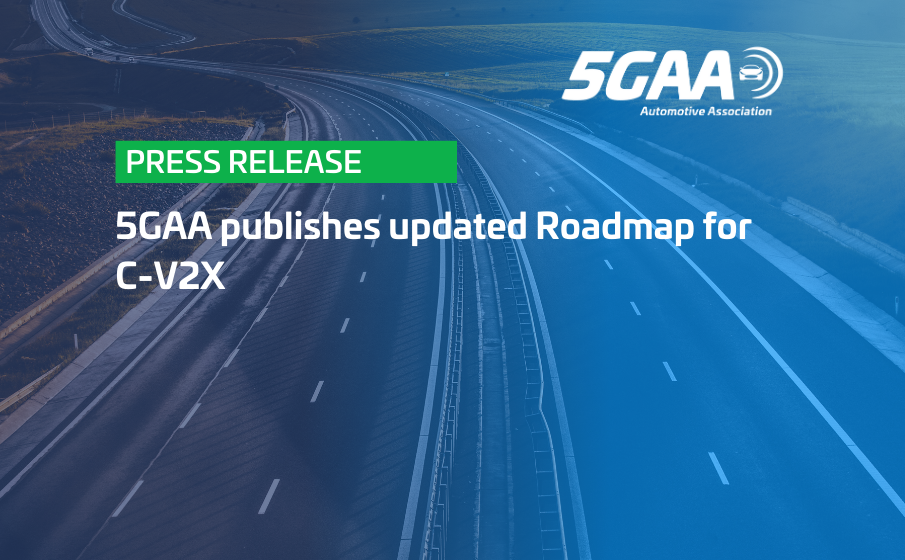
5GAA publishes updated Roadmap for C-V2X
BRUSSELS, 3 December 2024 – The 5G Automotive Association (5GAA) has sketched out an upbeat vision for better transportation safety, efficiency and sustainability with the third edition of its Roadmap for advanced driving use cases, connectivity, and technologies.
The 24-page Roadmap III builds upon a 5GAA white paper first published in 2020 and updated in 2022. It includes both a summary of market and technological developments since the last report as well as a forecast of the market readiness and roll-out of connected mobility technologies through 2030, with a focus on cellular-vehicle-to-everything (C-V2X) technology.
Thanks to the rapid expansion of cellular networks worldwide, about 300 million vehicles, including about two-thirds of all cars sold in the world’s major automotive markets, are now “connected.” Moreover, road and other infrastructure owners and operators have continued to expand a network of roadside sensors, traffic lights and other devices that help make transportation smarter, safer—including for pedestrians, cyclists and other vulnerable road users—and more sustainable.
While most vehicles and infrastructure to-date have relied on C-V2X technology to communicate with one another via cellular networks, the Roadmap also sees a growing role for “direct” vehicle-to-vehicle and related communications as soon as two years from now. 5GAA expects 5G-V2X Direct-enabled vehicles and related services to begin to be mass-deployed between 2026 and 2029, starting in Europe.
In addition, the third edition of the Roadmap for the first time describes a timeline for new use cases enabled by non-terrestrial networks and advanced Multi-Access Edge Computing (MEC). Satellite connectivity could help guarantee ubiquitous service in rural areas and disaster situations as soon as 2027, for example.
“Connected vehicle technologies and the market have both come a long way, since 2000,” said Maxime Flament, 5GAA Chief Technology Officer. “Our latest Roadmap foresees the continuous evolution of C-V2X cellular and direct communications technologies that will help save lives, make transportation more efficient and more sustainable and accelerate the spread of autonomous vehicles,” he said.
5GAA sees the Roadmap as a guide to help vehicle manufacturers, telecommunications network operators, road and other infrastructure owners and operators, as well as governments, understand the investments, speed and spectrum requirements needed to ensure the most efficient deployment of the new technologies and services. This, in turn, can help governments achieve their stated vision of zero road fatalities more quickly and also expedite the deployment of autonomous vehicles.
You can download the full Roadmap here.
About 5GAA
The 5G Automotive Association (5GAA) is a global, cross-industry organization of more than 115 members, including leading global automakers, Tier-1 suppliers, mobile operators, semiconductor companies, and test equipment vendors. 5GAA members work together to develop end-to-end solutions for future mobility and transport services. 5GAA is committed to helping define and develop the next generation of connected mobility, automated vehicles, and intelligent transport solutions based on C-V2X. For more information about 5GAA, please visit www.5GAA.org.
For further information please contact:
5GAA Marketing & Communications – Marcom@5GAA.org
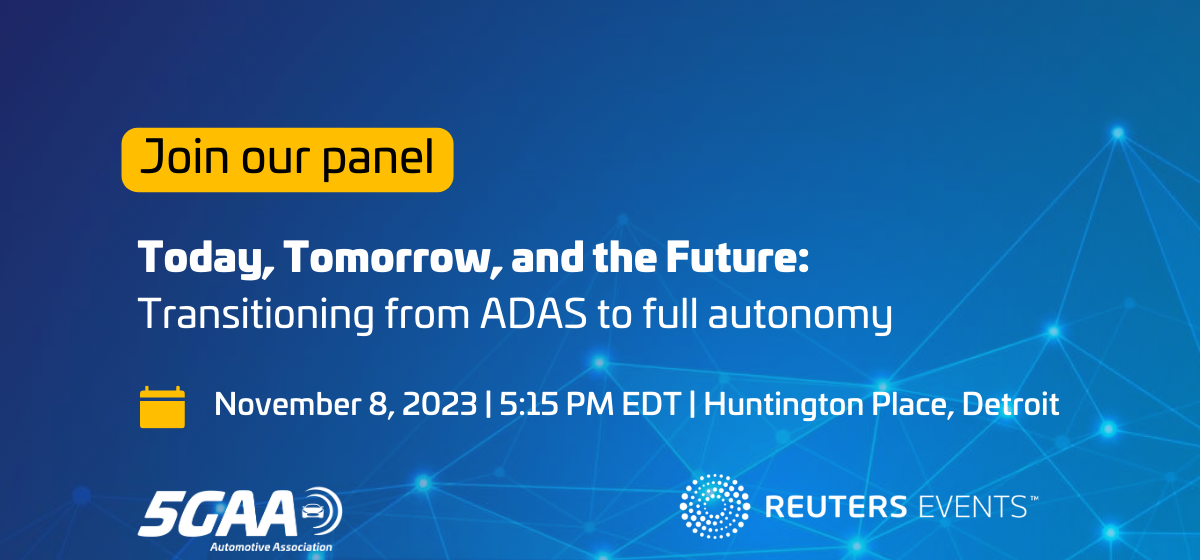
Automotive USA 2023
Accelerate Electrification, Innovate Software, Transform Manufacturing
The automotive industry is facing more disruption than ever before, with governmental initiatives and pressure to reduce emissions, growing concerns around vehicle safety, plans for an autonomous future, and the need to secure supply chains.
Reuters Events: Automotive USA (8-9 November, Huntington Place, Detroit) is where the industry meets to hear from trailblazing OEMs, cutting-edge solution providers, and government agencies to solve the challenges facing you. Learn from C-suite case studies, network with decision-makers, and walk away with actionable insights for your day-to-day and long-term strategies.
John Kwant, 5GAA Executive Director Americas, will moderate a panel session that will take a deep dive into the lates developments in autonomous driving technology.
Join us on November 8th, 5:15 PM EDT in Detroit to learn how the latest advances in AI including generative AI, will impact autonomous driving development. We will also look at different approaches being taken to transition from ADAS to L4 autonomy to meet market demands.
Visit the event website to find out more information.


Work Items
Completed Work Items – 2024
Objectives:
- Explore use cases, system requirements, and deployment options for integrating Vehicle-to-Everything (V2X) communication technologies with infrastructure sensors.
- Outline a framework for developing interoperable, standardised solutions that can operate efficiently within existing Intelligent Transportation System (ITS) spectrums.
Objective:
- Provide an update of 5GAA’s vision for the global deployment of smarter, safer and more sustainable mobility and transportation services.
Objectives:
- Provide the state of the art including demonstrations and market status, regulation, and safety-related aspect regarding uncrewed ground robots (UGRs) as well as common analysis and system/component requirements for UGRs.
- Show the methods of communication between UGRs and road users in view of existing gaps in ITS standards, to identify a way forward to incorporate UGRs in future standards.
Objective:
- Outline a vision for integrating a Non-Terrestrial Network (NTN) connectivity layer as a complement to Terrestrial Networks (TN), enhancing coverage and services for connected vehicles.
Objectives:
- Build on previous work in 5GAA on the topic of VRUs, focussing on co-existence and interoperability between different companies’ solutions.
- Previous showcases and demonstrations have shown the functionality and safety benefits of VRU protection solutions, whereas the objective of VRU-DEMO is to show how these solutions are able to interact with each other.
Objective:
- Explore how to manage misbehaviour in Vehicle-to-Everything (V2X) communication systems, where vehicles and infrastructure directly exchange information.
Objectives:
- Provide a business perspective on the Vehicle-to-Network-to-Everything (V2N2X) market, covering market value, stakeholder needs, market growth drivers, and business models observed in various deployments.
- The report complements the high-level V2N2X architecture described in the 5GAA white paper ‘Road traffic operation in a digital age’ and the technical report ‘Vehicle-to-Network-to-Everything (V2N2X) Communications; Architecture, Solution Blueprint, and Use Case Implementation Examples.’
Objectives:
- Describe an ecosystem for stakeholders on how to realise various V2X applications and use cases (UCs), using cellular network communications in combination with information sharing structures between backend systems.
- Clarify the different implementation options of the V2X application in a vehicle and their related implications.
- The report complements the V2N2X business perspectives in the 5GAA white paper ‘Road traffic operation in a digital age’ and the technical report ‘Business Perspectives on Vehicle-to-Network-to-Everything (V2N2X) Deployments’.
Objective:
- Propose a framework for trust assessment within CAVs by defining key terms related to trust and trustworthiness, establishing a foundation for building trust between these vehicles and creating a taxonomy for classifying different trust relationships.
Objectives:
- Develop a methodology specifically for testing vehicular communication antennas and provide validation measures that account for the unique form factors and characteristics of each vehicle.
- This document is an updated version of the Vehicular Antenna Test Methodology technical report published by 5GAA in 2021, available here.
Objectives:
- Reflect the automotive and connectivity industries agreement on spectrum allocation for ITS services in the 5.9 GHz band in Europe.
- This 5GAA position paper also takes into account the updates from ETSI and CEPT and proposes a deployment band configuration for road-ITS in the 5.9 GHz band.
Objectives:
- Propose a transformative approach for automotive stakeholders, emphasizing scalable digital data exchange and a federated architecture to manage road traffic information efficiently.
- Recommend a National Roadway Digital Strategy, federated information-sharing structures, and aligned investments.
Objective:
- Provide an overview of how security, privacy, and data quality are addressed for C-V2X using mobile network and backend communications, also known as Vehicle-to-Network-to-Everything (V2N2X) solutions.
Objective:
- The overview of cellular vehicle-to-everything (C-V2X) devices provides a fresh look at the devices currently available on the market or nearing release to capture the evolving C-V2X device landscape.
Completed Work Items – 2023
Objectives:
- Work with the Connected Motorcycle Consortium (CMC) to identify potential C-V2X technology solutions for
- use cases for powered two-wheelers, focusing on safety aspects
- This includes use cases enabled by external connectivity or sensors but also covers use cases that may profit or be enabled by the presence of external computing power, representing an attractive potential market even with low V2X penetration.
Objectives:
- Identify and evaluate a selection of evolving and emerging technologies for positioning in line with the 5GAA roadmap for use automotive use cases.
- Perform a gap analysis based on automotive use cases concerning selected technologies and provide feedback to relevant SDOs.
Objectives:
- Cover a broad range of topics, ranging from the analysis of MEC-relevant use cases and requirements, both from a technical and business perspective, the collaboration with SDOs and industry groups (GSMA), the definition of a reference architecture with related deployment scenarios, an early study on security and privacy aspects, and the drafting of a plan for future experimental activities on MEC for automotive services, including public demos.
Objective:
- Highlight the vast array of new business opportunities that 5G will enable for the connected mobility ecosystem by moving the discussion beyond safety and automated driving to other innovative solutions and customer experiences.
Objective:
- Consider realistic evaluation assumptions based on a common understanding between the automotive industry and 5G-V2X technology vendors.
Objectives:
- Address the issue of trustworthiness in relation to position information exchanged in the context of V2X communication(how much trust the ITS station can place on the received V2X message containing the positioning information).
- Provide an overview of the current standards related to positioning, including the integrity of the position and confidence levels, and review the definitions and metrics used so far.
Objective:
- Develop and socialise guidance documents on C-V2X direct communications RSU deployment in the USA with a focus on Day 1 (messages, minimum performance, interoperability and certification) to foster real-world infrastructure deployments.
Objectives:
- Accelerate the understanding and adoption of VRU protection services enabled by C-V2X to meet the 5GAA-proposed roadmap for deploying those services.
- This objective is addressed by experimentation and demonstrating existing technology and standards. Exploiting and analysing the results of the experiments and demonstrations enabled an assessment of the existing standards and potential standardisation gaps, laying the ground for the mass deployment of VRU protection services.
Completed Work Items – 2022
Objectives:
- Stimulate auto industry awareness in Conformity Assessment (CA) and conduct a study of current CA schemes being developed by global industry organizations.
- Develop a framework for a harmonized conformance assessment for PC5 applicable to both roadside units and on-board units and attain support from global industry bodies and stakeholders
Objectives:
- Define use cases and align the Use Case Roadmap for mass-market deployment of advanced driving use cases, including their technology and spectrum requirements.
Objectives:
- Analyze the feasibility of distributed vehicle antennas from an implementation perspective and develop measurement strategies for the analysis.
- Analyze the specification impact and the potential necessary changes, and provide output to relevant standardization organizations for possible requirements recommendations.
Objectives:
- Secure consumer acceptance and trust in V2X technologies, and perform lawful processing of data while preserving system efficiency to deliver upon the benefits of both basic and advanced V2X services.
Objectives:
- Produce a report which describes the actions which 5GAA and its members would need to take to ensure that relevant ETSI and CEPT deliverables are created as needed to support the 5GAA C-V2X Roadmap.
Objectives:
- Provide awareness of the current state of misbehaviour developments in standards developing organizations, and propose action items to fill the existing gaps.
Objectives:
- Continue incubation of new technical enablers, both use case specific and use case agnostic, with the intent of achieving sufficient maturity for transition to standards developing organizations .
- Contribute to SDOs via a Liaison member, bringing up new developments in foundational enablers and protocols for review and consumption by TCs & TFs.
Objectives:
- Review and update the specified methodology for the use case analysis for Predictive Quality of Service (QoS) related Service Level Requirements.
- Develop potential enhancements to interfaces, signalling and architecture of the Predictive Quality of Service (QoS) system, including but not limited to the aspects related to edge cloud and interoperability.
Objectives:
- Detect, propose and evaluate possibilities for telecommunication operators, vendors and further stakeholders to provide what is necessary in order to enable the car OEM to better treat safety.
- Investigate processes and tools used to develop and operate the complete chain of the system, deriving a judgement on feasibility of those processes for safety.
Objectives:
- Monitor the activities of standards developing organizations and provide regular updates of the ecosystem to 5GAA members to enable an early identification of risks and challenges in standardization.
Objectives:
- Introduce tele-operation service provider relevant use cases and scenarios with a V2N2V nature and identify gaps and develop architecture solutions for the development of tele-operated driving services
- Study framework requirements of a tele-operation service between vehicle and remote tele-operation centre in cross-mobile network operators, cross-original equipment manufacturers and cross-authority scenarios.
Objectives:
- Produce a C-V2X tolling white paper using the experience from the technology and cost analysis to show the tolling industry how to find common benefit in C-V2X and the importance of C-V2X in the future Road Digitalization Roadmap.
Objectives:
- Establish use case implementation descriptions realizing use cases’ Service Level Requirements for Automated Valet Parking (AVP), Informative Sensor sharing (HD map Collecting and Sharing), Sensor Sharing for Automated vehicles (AVs) and HD Sensor Sharing for AVs.
- Contribute to overarching application system implementation specifications combining the respective use case implementation specifications, including potential interfaces to network layer and security layer.
Objectives:
- Update and improve use case descriptions and corresponding Service Level Requirements in already published Technical Reports and White Papers.
- Collect, harmonize, align, and integrate new use case descriptions developed in 5GAA and publish the third volume of the Technical Report on C-V2X Use Cases and Service Level Requirements.
Objectives:
- Strengthen 5GAA members’ understanding of the state of play of V2X in China and improve the cooperation with and among Chinese members.
Objectives:
- Publish an industry specification defining a system profile to enable US deployment of interoperable basic safety services using LTE-V2X direct communication over channel 183.
Objectives:
- Establish qualitative general, functional and operational requirements to describe systems for the 5G evolution and beyond that would be useful for automotive solutions.
- Provide a unified 5GAA opinion on evolving technologies and the expected transition path for the automotive ecosystem when moving from current 5G technology to its evolution, including potential threats and opportunities.
Completed Work Items – 2021
Objectives:
- Gather evidence of the environmental benefits associated with C-V2X and assist in developing this evidence into a compelling narrative.
- Assess the benefits of C-V2X deployment (both LTE-V2X and 5G-V2X direct and network-based communications) in terms of emission reduction by 2050 in Europe (and for US and Asia) considering various positive and negative externalities.
Objectives:
- Identify and investigate further potential enhancements needed to provide Predictive Quality of Service (QoS) for C-V2X, investigate interoperability of network slices, and provide relevant recommendations to standards developing organizations (SDOs) and industry forums, e.g. 3GPP, ETSI, ISO and GSMA.
Objectives:
- Demonstrate the use of multi-access edge computing (MEC) technology for automotive services, for example, when two distinct automotive vendors can truly test at least three use cases involving two distinct mobile network operators (MNOs) employing the network infrastructure provided by two distinct infrastructure vendors.
- Increase the flexibility of the current network service architecture, reduce the deployment effort, and increase the interoperability among different stakeholders in the system.
Objectives:
- Describe how existing 3GPP methods reduce and improve service interruption due to network reselection.
- Provide an original equipment manufacturer (OEM) view on current and desired network reselection.
Objective:
- Close the gap of the first spectrum needs study by analyzing several advanced use cases and consider additional items such as security overheads in a second release.
Objective:
- Prepare a report which describes the 5GAA’s 5.9 GHz radio channel deployment options for use by LTE-V2X and NR-V2X across all regions, and describe relevant changes to existing regulatory frameworks – or the introduction of new regulatory frameworks – which may be required across all regions.
Objectives:
- Update Use Case Technical Reports with updated use case descriptions and develop a white paper for the Wave 2 of use cases.
- Provide a new set of use cases with their corresponding service level requirements (SLRs) to be summarized into a new TR.
Objectives:
- Study and describe specific and technology dependent use case implementations that fulfil the service level requirements (SLRs) as defined in the technology agnostic 5GAA use case descriptions.
- Develop corresponding descriptions for three exemplary use cases: Left Turn Assist (LTA), (Electronic) Emergency Brake (light) Warning (EEBL), and Traffic Jam Warning and Route Information.
Objective:
- Define a standardized test method and metrics for vehicular antennas with the dominant emittance toward the outside of the vehicle, focusing on vehicular antennas for telecommunications (2G, 3G, 4G, 5G (< 7.125GHz)), vehicular antennas for direct communication between vehicles to road infrastructure (operating in the designated ITS frequency spectrum (5.9GHz range)), GNSS antennas and 3D-measurements (vehicle-mounted antenna element)
Objectives:
- Focus on positioning method for vehicles and vulnerable road users (VRUs) and study both positioning methods employing cellular signals (5G/LTE/C-V2X) and the positioning methods integrated with other technologies.
- Study the requirements of positioning, build the understanding of positioning system framework, and offer the corresponding technologies according to the requirements and environments.
Completed Work Items – 2020
Objective:
- Analyze V2I deployment costs, including financial, economic and market aspects, to provide guidance to regulators, policymakers and other key stakeholders.
- Analyse options with higher and lower levels of V2I-based infrastructure vs. V2N-based approach.
Objective:
- Define and analyse the automotive use case requirements in terms of Quality of Service (QoS) using network slicing and analyze business value and identify the specific features required to support the automotive use cases that cover IoT and mobile broadband services.
Objectives:
- Define use cases and align the Use Case Roadmap for mass-market deployment of advanced driving use cases, including their technology and spectrum requirements.
Map, assess and contribute to the identification of technical gaps (upper and lower layers, e.g. protocols, Rel. 18 requirements) and forward to relevant standards setting organizations (SSOs).
Objectives:
- Define all necessary details for conducting the first 5GAA C-V2X Plugfest in the first quarter of 2019.
- Define 5GAA requirements and timelines for conducting successive plugfests after the first quarter of 2019.
Objective:
- Facilitate a harmonized industrial evolution and development of enhanced cellular V2X, starting with supporting the basic use cases with the already available C-V2X technologies such as 3GPP Rel-14/15 C-V2X and adopt new technologies for the use cases which cannot be served with current C-V2X
Objectives:
- Establish a lightweight security system for C-V2X/5G-V2X communications by conducting a requirements analysis of regional privacy regulations to establish an overview of regional differences and define requirements for each region.
- Analyze concepts to simplify the architecture and its impact on regional privacy compliance.
Objectives:
- Identify structured and reasonable requirements on mobile networks relevant to spectrum auctioning to accommodate automotive use cases and enable mobile network operator (MNOs) to quantify associated investments.
- Analyze licensed spectrum auctioning frameworks and other incentivizing initiatives, such as infrastructure leasing exceptions, where additional investments required by mobile network operators (MNOs) to fulfill requirements associated to automotive use cases are appropriately recognized.
Objectives:
- Develop application-level groundwork for the next-generation services (Rel-16) with use cases involving complex message interactions for assisted and autonomous (Ll1-Ll5) and automated driving (supported by infrastructure).
- Build prototypes and demonstrate next-generation applications (Rel-16 and further) to gain hands-on experience with some use cases to help stakeholders (OEMs, suppliers, road operators, regulators) understand how 5G NR can implement the concept of connected and automated vehicles for proximal vehicle-to-X coordination and cooperation.
Objective:
- Solicit road operators’ views on their role in the deployment of ITS C-V2X services through a free form questionnaire to determine the road operator willingness to participate directly in future 5GAA discussions or events.
Objectives:
- Develop and demonstrate a phased vulnerable road user (VRU) protection approach by defining a VRU protection roadmap.
- Provide realistic paths for vulnerable road user (VRU) protection using cellular communications, differentiating C-V2X from 802.11p based technologies and set the stage for application of C-V2X to VRU protection.
Objectives:
- Define the application layer reference architecture for the V2X service and recommend the application layer reference architecture of the V2X system.
- Discuss other architecture related subjects to align with the coordinated 5GAA architecture.
Completed Work Items – 2019
Objective:
- Identify, analyze and compare the advantages and disadvantages of V2I deployment using long-range (Uu) mobile networks and RSU (PC5) from a business perspective, reflecting how C-V2X enables synergies with both the transportation and telecommunications infrastructure, which includes leveraging existing mobile network infrastructure for C-ITS.
Objectives:
- Work on the CEPT/ETSI-related activities by extending the ITS safety-related band at 5.9 GHz to allow coexistence of LTE V2X and Urban Rail to coexist with ITS-G5 within the 5,875-5,925 MHz frequency band.
- Clarify ITS “co-frequency coexistence” statements, include future 3GPP releases and evolution, engage the urban rail community, engage with national administrations.
Objectives:
- Develop a trial and interoperability testing framework that defines the deployment scenarios and uses cases, testing methodologies, key performance indicators (KPIs) to be tested.
- Develop a 5GAA trial and interoperability testing strategy to capture the 5GAA testing priorities, including setting up a 5GAA testbed environment and planning multi-partner trials covering the priority test cases.
Objective:
- Prepare input material for the work in ETSI TC ITS to amend the test specification required to use LTE-V2X as the underlying access layer technology.
Objectives:
- Identify and evaluate potential architecture enhancements needed to provide predictable Quality of Service (QoS) for C-V2X in 5G for the automotive industry, utilizing network slicing and edge computing technologies.
- Provide guidelines on the design of Network Slice Templates (NST) for the automotive industry that enable support for different categories of C-V2X use cases and 5GAA requirements.
Objectives:
- Provide an assessment of the deployment roadmap for use cases.
- Establish a mapping between use cases and potential technology candidates, e.g. 3GPP releases, sidelink and/or Uu requirements.
Objectives:
- Define a framework for classifying use cases and requirements, identify prioritized use cases, functional requirements and key performance indicators (KPIs).
- Perform a gap analysis and specify the extended set of prioritized use cases.
Objectives:
- Identify the use cases that benefited from the presence of an application server, and based on the output, explore the V2X application server features and how the application server can be used to perform these use cases.
Completed Work Items – 2018
Objectives:
- Develop consensus on operating models for system implementation, taking into account the various requirements arising from the planned networked transport services.
- Investigate architectural paradigms such as cloud-based solutions, including edge computing aspects, and analyze solutions from the perspective of verification, confidentiality and privacy, identify requirements and key performance indicators (KPIs), and recommend further actions.
Objective:
- Enable the development of a strategy for comprehensive testing, trials, demo pilots, and compliance assessment for V2X using cellular air interface specifications (i.e., including PC5 and Uu).
Objectives:
- Promote C-V2X, including existing (LTE-V2X PC5 and Uu interfaces) and future realizations, as the technology of choice for ITS and promote ITS in 5.9 GHz spectrum in some areas, and interact various regulatory organizations.
- Comment FO: This WI did not have an acronym.
Objectives:
- Promote C-V2X, including its existing (LTE-V2X) and future realizations, as the technology of choice for ITS.
- Promote appropriate availability of radio spectrum for C-V2X where necessary in addition to 5.9 GHz, and promote the use of 5.9 GHz for safety-related ITS over other applications (e.g., RLANs, CBTC).
- Comment FO: This WI did not have an acronym.
Objectives:
- Quantify the future spectrum needs for 5G short-range V2X communications in the context of safety-related ITS spectrum allocation and 5G wide range communications.
- Comment FO: This WI did not have an acronym.
Objectives:
- Develop recorded test procedures to validate various performance and functional requirements of C-V2X technology covering both the laboratory/test bed and the field test environments.
Objectives:
- Quantify future spectrum needs for 5G V2X communications related to ITS spectrum allocation for advanced use cases, including a technology assessment of the amount of radio spectrum needed to meet the key performance criteria related to the low frequency band (e.g. 5.9 GHz) as well as mmWave (e.g. 63–64 GHz) for various advanced ITS applications and a wide-area 4G/5G Uu interface.
- Comment FO: This WI did not have an acronym.
Completed Work Items – 2017
Objective:
- Establish a high-level plan for C-V2X trials in North America, including definition of trial scope and objectives, identification of suitable/preferred trial facilities, and guidance regarding preferred trial participant composition.
Objective:
- Identify existing regional V2X application specifications that have some dependency on specific radio access technologies, such as ITS-G5/11p, and determine how these specifications can be adapted to interoperate with generic radio access technologies and, in particular, with the lower layers of ITS-Cellular specified by 3GPP.
Objective:
- Develop the timeline of major functionalities and milestones describing the expected availability of monetizable items and associated business and/or operational model options.
Objectives:
- Identify sensor data sharing requirements from planned automated driving applications, including architecture options, requirements and implications.
- Conduct a gap analysis of ETSI ITS standards related to existing data objects and complete a technical report outlining the 5GAA framework for sensor data sharing for V2X applications.
Objective:
- Prepare a survey report on finalized, on-going and planned test activities, established testbeds and simulation frameworks.
Objective:
- Compile V2X communication terms and definitions to be used within the 5GAA.
Completed Work Items – 2023
Objectives:
- Work with the Connected Motorcycle Consortium (CMC) to identify potential C-V2X technology solutions for
- use cases for powered two-wheelers, focusing on safety aspects
- This includes use cases enabled by external connectivity or sensors but also covers use cases that may profit or be enabled by the presence of external computing power, representing an attractive potential market even with low V2X penetration.
Objectives:
- Identify and evaluate a selection of evolving and emerging technologies for positioning in line with the 5GAA roadmap for use automotive use cases.
- Perform a gap analysis based on automotive use cases concerning selected technologies and provide feedback to relevant SDOs.
Objectives:
- Cover a broad range of topics, ranging from the analysis of MEC-relevant use cases and requirements, both from a technical and business perspective, the collaboration with SDOs and industry groups (GSMA), the definition of a reference architecture with related deployment scenarios, an early study on security and privacy aspects, and the drafting of a plan for future experimental activities on MEC for automotive services, including public demos.
Objectives:
- Highlight the vast array of new business opportunities that 5G will enable for the connected mobility ecosystem by moving the discussion beyond safety and automated driving to other innovative solutions and customer experiences.
Objectives:
- Address the operational aspects of misbehaviour detection, explicitly looking into remediation classification, misbehaviour classification and misbehaviour remediation.
Objectives:
- Analyse and evaluate the performance of 3GPP NR-V2X sidelink and draw conclusions and recommendations for its operation, including gap analysis covering future releases and engagements with relevant SDOs.
Objectives:
- Address the issue of trustworthiness in relation to position information exchanged in the context of V2X communication(how much trust the ITS station can place on the received V2X message containing the positioning information).
- Provide an overview of the current standards related to positioning, including the integrity of the position and confidence levels, and review the definitions and metrics used so far.
Objectives:
- Develop and socialise guidance documents on C-V2X direct communications RSU deployment in the USA with a focus on Day 1 (messages, minimum performance, interoperability and certification) to foster real-world infrastructure deployments.
Objectives:
- Accelerate the understanding and adoption of VRU protection services enabled by C-V2X to meet the 5GAA-proposed roadmap for deploying those services.
- This objective is addressed by experimentation and demonstrating existing technology and standards. Exploiting and analysing the results of the experiments and demonstrations enabled an assessment of the existing standards and potential standardisation gaps, laying the ground for the mass deployment of VRU protection services.
Completed Work Items – 2022
Objectives:
- Stimulate auto industry awareness in Conformity Assessment (CA) and conduct a study of current CA schemes being developed by global industry organizations.
- Develop a framework for a harmonized conformance assessment for PC5 applicable to both roadside units and on-board units and attain support from global industry bodies and stakeholders
Objectives:
- Define use cases and align the Use Case Roadmap for mass-market deployment of advanced driving use cases, including their technology and spectrum requirements.
Objectives:
- Analyze the feasibility of distributed vehicle antennas from an implementation perspective and develop measurement strategies for the analysis.
- Analyze the specification impact and the potential necessary changes, and provide output to relevant standardization organizations for possible requirements recommendations.
Objectives:
- Secure consumer acceptance and trust in V2X technologies, and perform lawful processing of data while preserving system efficiency to deliver upon the benefits of both basic and advanced V2X services.
Objectives:
- Produce a report which describes the actions which 5GAA and its members would need to take to ensure that relevant ETSI and CEPT deliverables are created as needed to support the 5GAA C-V2X Roadmap.
Objectives:
- Provide awareness of the current state of misbehaviour developments in standards developing organizations, and propose action items to fill the existing gaps.
Objectives:
- Continue incubation of new technical enablers, both use case specific and use case agnostic, with the intent of achieving sufficient maturity for transition to standards developing organizations .
- Contribute to SDOs via a Liaison member, bringing up new developments in foundational enablers and protocols for review and consumption by TCs & TFs.
Objectives:
- Review and update the specified methodology for the use case analysis for Predictive Quality of Service (QoS) related Service Level Requirements.
- Develop potential enhancements to interfaces, signalling and architecture of the Predictive Quality of Service (QoS) system, including but not limited to the aspects related to edge cloud and interoperability.
Objectives:
- Detect, propose and evaluate possibilities for telecommunication operators, vendors and further stakeholders to provide what is necessary in order to enable the car OEM to better treat safety.
- Investigate processes and tools used to develop and operate the complete chain of the system, deriving a judgement on feasibility of those processes for safety.
Objectives:
- Monitor the activities of standards developing organizations and provide regular updates of the ecosystem to 5GAA members to enable an early identification of risks and challenges in standardization.
Objectives:
- Introduce tele-operation service provider relevant use cases and scenarios with a V2N2V nature and identify gaps and develop architecture solutions for the development of tele-operated driving services
- Study framework requirements of a tele-operation service between vehicle and remote tele-operation centre in cross-mobile network operators, cross-original equipment manufacturers and cross-authority scenarios.
Objectives:
- Produce a C-V2X tolling white paper using the experience from the technology and cost analysis to show the tolling industry how to find common benefit in C-V2X and the importance of C-V2X in the future Road Digitalization Roadmap.
Objectives:
- Establish use case implementation descriptions realizing use cases’ Service Level Requirements for Automated Valet Parking (AVP), Informative Sensor sharing (HD map Collecting and Sharing), Sensor Sharing for Automated vehicles (AVs) and HD Sensor Sharing for AVs.
- Contribute to overarching application system implementation specifications combining the respective use case implementation specifications, including potential interfaces to network layer and security layer.
Objectives:
- Update and improve use case descriptions and corresponding Service Level Requirements in already published Technical Reports and White Papers.
- Collect, harmonize, align, and integrate new use case descriptions developed in 5GAA and publish the third volume of the Technical Report on C-V2X Use Cases and Service Level Requirements.
Objectives:
- Strengthen 5GAA members’ understanding of the state of play of V2X in China and improve the cooperation with and among Chinese members.
Objectives:
- Publish an industry specification defining a system profile to enable US deployment of interoperable basic safety services using LTE-V2X direct communication over channel 183.
Objectives:
- Establish qualitative general, functional and operational requirements to describe systems for the 5G evolution and beyond that would be useful for automotive solutions.
- Provide a unified 5GAA opinion on evolving technologies and the expected transition path for the automotive ecosystem when moving from current 5G technology to its evolution, including potential threats and opportunities.
Completed Work Items – 2021
Objectives:
- Gather evidence of the environmental benefits associated with C-V2X and assist in developing this evidence into a compelling narrative.
- Assess the benefits of C-V2X deployment (both LTE-V2X and 5G-V2X direct and network-based communications) in terms of emission reduction by 2050 in Europe (and for US and Asia) considering various positive and negative externalities.
Objectives:
- Identify and investigate further potential enhancements needed to provide Predictive Quality of Service (QoS) for C-V2X, investigate interoperability of network slices, and provide relevant recommendations to standards developing organizations (SDOs) and industry forums, e.g. 3GPP, ETSI, ISO and GSMA.
Objectives:
- Demonstrate the use of multi-access edge computing (MEC) technology for automotive services, for example, when two distinct automotive vendors can truly test at least three use cases involving two distinct mobile network operators (MNOs) employing the network infrastructure provided by two distinct infrastructure vendors.
- Increase the flexibility of the current network service architecture, reduce the deployment effort, and increase the interoperability among different stakeholders in the system.
Objectives:
- Describe how existing 3GPP methods reduce and improve service interruption due to network reselection.
- Provide an original equipment manufacturer (OEM) view on current and desired network reselection.
Objective:
- Close the gap of the first spectrum needs study by analyzing several advanced use cases and consider additional items such as security overheads in a second release.
Objective:
- Prepare a report which describes the 5GAA’s 5.9 GHz radio channel deployment options for use by LTE-V2X and NR-V2X across all regions, and describe relevant changes to existing regulatory frameworks – or the introduction of new regulatory frameworks – which may be required across all regions.
Objectives:
- Update Use Case Technical Reports with updated use case descriptions and develop a white paper for the Wave 2 of use cases.
- Provide a new set of use cases with their corresponding service level requirements (SLRs) to be summarized into a new TR.
Objectives:
- Study and describe specific and technology dependent use case implementations that fulfil the service level requirements (SLRs) as defined in the technology agnostic 5GAA use case descriptions.
- Develop corresponding descriptions for three exemplary use cases: Left Turn Assist (LTA), (Electronic) Emergency Brake (light) Warning (EEBL), and Traffic Jam Warning and Route Information.
Objective:
- Define a standardized test method and metrics for vehicular antennas with the dominant emittance toward the outside of the vehicle, focusing on vehicular antennas for telecommunications (2G, 3G, 4G, 5G (< 7.125GHz)), vehicular antennas for direct communication between vehicles to road infrastructure (operating in the designated ITS frequency spectrum (5.9GHz range)), GNSS antennas and 3D-measurements (vehicle-mounted antenna element)
Objectives:
- Focus on positioning method for vehicles and vulnerable road users (VRUs) and study both positioning methods employing cellular signals (5G/LTE/C-V2X) and the positioning methods integrated with other technologies.
- Study the requirements of positioning, build the understanding of positioning system framework, and offer the corresponding technologies according to the requirements and environments.
Completed Work Items – 2020
Objective:
- Analyze V2I deployment costs, including financial, economic and market aspects, to provide guidance to regulators, policymakers and other key stakeholders.
- Analyse options with higher and lower levels of V2I-based infrastructure vs. V2N-based approach.
Objective:
- Define and analyse the automotive use case requirements in terms of Quality of Service (QoS) using network slicing and analyze business value and identify the specific features required to support the automotive use cases that cover IoT and mobile broadband services.
Objectives:
- Define use cases and align the Use Case Roadmap for mass-market deployment of advanced driving use cases, including their technology and spectrum requirements.
Map, assess and contribute to the identification of technical gaps (upper and lower layers, e.g. protocols, Rel. 18 requirements) and forward to relevant standards setting organizations (SSOs).
Objectives:
- Define all necessary details for conducting the first 5GAA C-V2X Plugfest in the first quarter of 2019.
- Define 5GAA requirements and timelines for conducting successive plugfests after the first quarter of 2019.
Objective:
- Facilitate a harmonized industrial evolution and development of enhanced cellular V2X, starting with supporting the basic use cases with the already available C-V2X technologies such as 3GPP Rel-14/15 C-V2X and adopt new technologies for the use cases which cannot be served with current C-V2X
Objectives:
- Establish a lightweight security system for C-V2X/5G-V2X communications by conducting a requirements analysis of regional privacy regulations to establish an overview of regional differences and define requirements for each region.
- Analyze concepts to simplify the architecture and its impact on regional privacy compliance.
Objectives:
- Identify structured and reasonable requirements on mobile networks relevant to spectrum auctioning to accommodate automotive use cases and enable mobile network operator (MNOs) to quantify associated investments.
- Analyze licensed spectrum auctioning frameworks and other incentivizing initiatives, such as infrastructure leasing exceptions, where additional investments required by mobile network operators (MNOs) to fulfill requirements associated to automotive use cases are appropriately recognized.
Objectives:
- Develop application-level groundwork for the next-generation services (Rel-16) with use cases involving complex message interactions for assisted and autonomous (Ll1-Ll5) and automated driving (supported by infrastructure).
- Build prototypes and demonstrate next-generation applications (Rel-16 and further) to gain hands-on experience with some use cases to help stakeholders (OEMs, suppliers, road operators, regulators) understand how 5G NR can implement the concept of connected and automated vehicles for proximal vehicle-to-X coordination and cooperation.
Objective:
- Solicit road operators’ views on their role in the deployment of ITS C-V2X services through a free form questionnaire to determine the road operator willingness to participate directly in future 5GAA discussions or events.
Objectives:
- Develop and demonstrate a phased vulnerable road user (VRU) protection approach by defining a VRU protection roadmap.
- Provide realistic paths for vulnerable road user (VRU) protection using cellular communications, differentiating C-V2X from 802.11p based technologies and set the stage for application of C-V2X to VRU protection.
Objectives:
- Define the application layer reference architecture for the V2X service and recommend the application layer reference architecture of the V2X system.
- Discuss other architecture related subjects to align with the coordinated 5GAA architecture.
Completed Work Items – 2019
Objective:
- Identify, analyze and compare the advantages and disadvantages of V2I deployment using long-range (Uu) mobile networks and RSU (PC5) from a business perspective, reflecting how C-V2X enables synergies with both the transportation and telecommunications infrastructure, which includes leveraging existing mobile network infrastructure for C-ITS.
Objectives:
- Work on the CEPT/ETSI-related activities by extending the ITS safety-related band at 5.9 GHz to allow coexistence of LTE V2X and Urban Rail to coexist with ITS-G5 within the 5,875-5,925 MHz frequency band.
- Clarify ITS “co-frequency coexistence” statements, include future 3GPP releases and evolution, engage the urban rail community, engage with national administrations.
Objectives:
- Develop a trial and interoperability testing framework that defines the deployment scenarios and uses cases, testing methodologies, key performance indicators (KPIs) to be tested.
- Develop a 5GAA trial and interoperability testing strategy to capture the 5GAA testing priorities, including setting up a 5GAA testbed environment and planning multi-partner trials covering the priority test cases.
Objective:
- Prepare input material for the work in ETSI TC ITS to amend the test specification required to use LTE-V2X as the underlying access layer technology.
Objectives:
- Identify and evaluate potential architecture enhancements needed to provide predictable Quality of Service (QoS) for C-V2X in 5G for the automotive industry, utilizing network slicing and edge computing technologies.
- Provide guidelines on the design of Network Slice Templates (NST) for the automotive industry that enable support for different categories of C-V2X use cases and 5GAA requirements.
Objectives:
- Provide an assessment of the deployment roadmap for use cases.
- Establish a mapping between use cases and potential technology candidates, e.g. 3GPP releases, sidelink and/or Uu requirements.
Objectives:
- Define a framework for classifying use cases and requirements, identify prioritized use cases, functional requirements and key performance indicators (KPIs).
- Perform a gap analysis and specify the extended set of prioritized use cases.
Objectives:
- Identify the use cases that benefited from the presence of an application server, and based on the output, explore the V2X application server features and how the application server can be used to perform these use cases.
Completed Work Items – 2018
Objectives:
- Develop consensus on operating models for system implementation, taking into account the various requirements arising from the planned networked transport services.
- Investigate architectural paradigms such as cloud-based solutions, including edge computing aspects, and analyze solutions from the perspective of verification, confidentiality and privacy, identify requirements and key performance indicators (KPIs), and recommend further actions.
Objective:
- Enable the development of a strategy for comprehensive testing, trials, demo pilots, and compliance assessment for V2X using cellular air interface specifications (i.e., including PC5 and Uu).
Objectives:
- Promote C-V2X, including existing (LTE-V2X PC5 and Uu interfaces) and future realizations, as the technology of choice for ITS and promote ITS in 5.9 GHz spectrum in some areas, and interact various regulatory organizations.
- Comment FO: This WI did not have an acronym.
Objectives:
- Promote C-V2X, including its existing (LTE-V2X) and future realizations, as the technology of choice for ITS.
- Promote appropriate availability of radio spectrum for C-V2X where necessary in addition to 5.9 GHz, and promote the use of 5.9 GHz for safety-related ITS over other applications (e.g., RLANs, CBTC).
- Comment FO: This WI did not have an acronym.
Objectives:
- Quantify the future spectrum needs for 5G short-range V2X communications in the context of safety-related ITS spectrum allocation and 5G wide range communications.
- Comment FO: This WI did not have an acronym.
Objectives:
- Develop recorded test procedures to validate various performance and functional requirements of C-V2X technology covering both the laboratory/test bed and the field test environments.
Objectives:
- Quantify future spectrum needs for 5G V2X communications related to ITS spectrum allocation for advanced use cases, including a technology assessment of the amount of radio spectrum needed to meet the key performance criteria related to the low frequency band (e.g. 5.9 GHz) as well as mmWave (e.g. 63–64 GHz) for various advanced ITS applications and a wide-area 4G/5G Uu interface.
- Comment FO: This WI did not have an acronym.
Completed Work Items – 2017
Objective:
- Establish a high-level plan for C-V2X trials in North America, including definition of trial scope and objectives, identification of suitable/preferred trial facilities, and guidance regarding preferred trial participant composition.
Objective:
- Identify existing regional V2X application specifications that have some dependency on specific radio access technologies, such as ITS-G5/11p, and determine how these specifications can be adapted to interoperate with generic radio access technologies and, in particular, with the lower layers of ITS-Cellular specified by 3GPP.
Objective:
- Develop the timeline of major functionalities and milestones describing the expected availability of monetizable items and associated business and/or operational model options.
Objectives:
- Identify sensor data sharing requirements from planned automated driving applications, including architecture options, requirements and implications.
- Conduct a gap analysis of ETSI ITS standards related to existing data objects and complete a technical report outlining the 5GAA framework for sensor data sharing for V2X applications.
Objective:
- Prepare a survey report on finalized, on-going and planned test activities, established testbeds and simulation frameworks.
Objective:
- Compile V2X communication terms and definitions to be used within the 5GAA.
Active Work Items
This work item will drive the study on the trends and evolution of current technologies. The objectives of the work item consist of:
- Establish qualitative general, functional and operational requirements that would describe systems for the5G evolution and beyond that would be useful for automotive solutions,
- Conduct a SWOT analysis with the automotive industry with respect to evolving technologies in a timeframe of 5, 10 and/or 15 years,
- Providing a unified 5GAA opinion (in the form of a white paper) on evolving technologies and the expected transition path for the Automotive
- Ecosystem when moving from current 5G to its evolution, including the potential threats and opportunities.
This Work Item assesses the required communication technology to support Automated Valet Parking (AVP) as specified by the 5GAA Use Cases T-210023, T-190139 and T-190140 and their respective Service Level Requirements (SLR).
This Work Item assesses the required communication technology to support Automated Valet Parking (AVP) as specified by the 5GAA Use Cases T-210023, T-190139 and T-190140 and their respective Service Level Requirements (SLR).
This Work Item consists of:
- Stimulate Auto Industry awareness in CA
- Study of current CA schemes being developed by global industry organisations
- Develop a framework for harmonized PC5 CA applicable to both RSUs and OBUs and attain support from global industry bodies and stakeholders
This Work Item aims at:
- Create a list of devices and update it every 6 months
- Define KPIs of the Dashboard and the format of the dashboard presentation
- Verify 5GAA’s market predictions
- Ensure legal compliance
- Create the first dashboard for publication
A joint Work Item with the Connected Motorcycle Consortium, this WI will look into CV2X enabled use cases for motorcycles mainly focusing on safety
Definition of all Use Cases and alignment of UC roadmap for mass-market deployment of advanced driving Use Cases, inc. their technology and spectrum requirements.
A comprehensive overview of the privacy and data protection regulatory framework.
A report which describes the actions which 5GAA and its members would need to take in order to ensure that relevant ETSI and CEPT deliverables are created as needed to support the 5GAA C-V2X Roadmap.
Publications
This Work Item consists of:
- Moving toward federated MEC demos/trials (global MEC);
- MEC System interoperability and test framework;
- usage of predictive edge analytics and situation awareness for closed-loop adaptation in multi-MNO and multi-OEM MEC scenarios (synergy and inputs from NESQO,eNESQO,V2XSRA PRESA);
This Work Item aims at discussing attractive selling points for CV2X for both final customers and OEMs beyond the usually discussed ADAS and safety features.
This Work Item:
- Provides awareness of current state of MBD developments in SDOs and trials/demos, and proposes action items to fill the existing gaps.
- Delivers content on: (1) concepts and terms definitions, V2X message stack, (2) overview of related/existing work and gaps, (3) Threat and Risk Assessment (TARA) and requirements for Day-1 applications, (4) determination of application domain-specific mitigation, and (5) legal aspects and recommendation of a strategy.
This Work Item aims at:
- Continue incubation of new technical enablers, both UC specific and agnostic for transition to SDOs.
- Contribute to SDOs via a Liaison member & Individual contributors from member companies will work directly on relevant standards projects on an ongoing basis.
This Work Item consists of:
- Review and update the specified methodology for the UC’ analysis for Predictive QoS related SLRs.
- Study application and system reactions.
- Develop potential enhancements to interfaces, signalling and architecture of the P-QoS system, including but not limited to the aspects related to edge cloud and interoperability.
- Provide input to SDOs.
This Work Item consists of:
- Monitor SDOs activities on and provide regular updates of the ecosystem to 5GAA members. This will enable early identification of risks and challenges in standardisation.
- Prepare contributions by 5GAA to critical SDOs.
- Support WGs and WIs intending to provide inputs to SDOs.
- Support 5GAA messaging in SDO related events.
This Work Item:
- Explore the use of C-V2X to enable electronic toll collection in China (ETC)
- Constructive advice about Investment, Performance Improvement and migration for C-V2X Tolling Implementation in China
- Find common benefits between Road Industries and 5GAA
This Work Item consists of:
- Update White Paper on C-V2X Use Cases: Methodology, Examples and Service Level Requirements [3].
- Update TRs Vol. I [1] and Vol. II [2] as needed.
- Update WP Vol. I [3] and Vol. II [4] as needed.
- Create new TR (Vol. III) with new UCs.
This Work Item consists of:
- Description of applicable measurement configurations
- Description of test procedures
- Definition of relevant metrics
Accelerate the understanding and adoption of VRU protection services enabled by C-V2X” in order to meet the 5GAA-proposed roadmap for the deployment of those services.
Completed Work Items – 2020
Lorem ipsum
Lorem ipsum
Completed Work Items – 2020
Lorem ipsum
Lorem ipsum
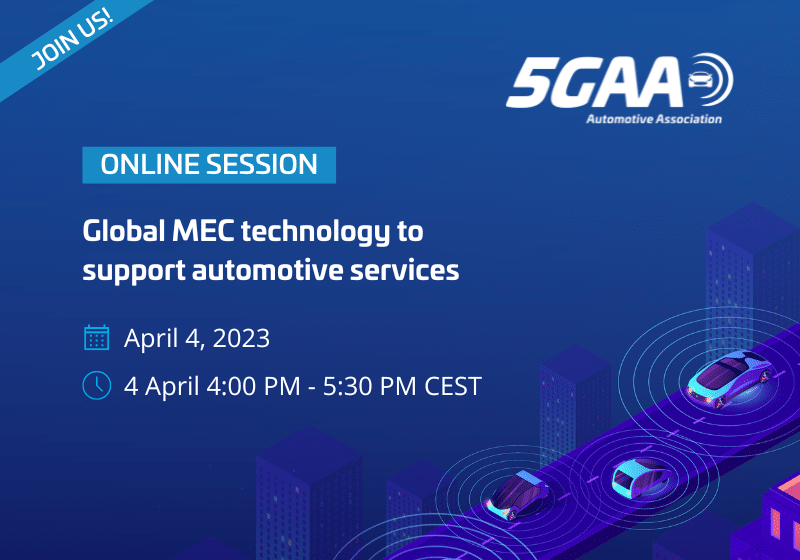
5GAA online session on Global MEC technology
5G Automotive Association is pleased to invite you to our online session, “Global MEC technology to support automotive services“, taking place on April 4th from 4:00 to 5:30 PM (CET).
The 5GAA approach to MEC (Multi-access Edge Computing) technology for automotive services follows car industry needs to consider multi-operator, multiple car maker, and multi-vendor scenarios.
In order to support global MEC deployments, 5GAA started working since 2019 on this area by targeting live trials to easily demonstrate MEC applications and use cases in those scenarios of interest (MEC4AUTO approach).
This webinar will provide a comprehensive overview of the many recent activities in this field, including architectural insights inspired by live trials implementations with 5G networks, interoperability and testing aspects, business and market considerations, but also technology aspects, standardization impacts, usage of edge predictive analytics, network slicing and cybersecurity aspects for the targeted scenarios.
Attendants of the webinar will get an updated view of real-life issues related to global MEC deployments, both from technical and business perspectives, together with an anticipation of future 5GAA activities in this field.
Watch the recording here.
Download the presentation here.
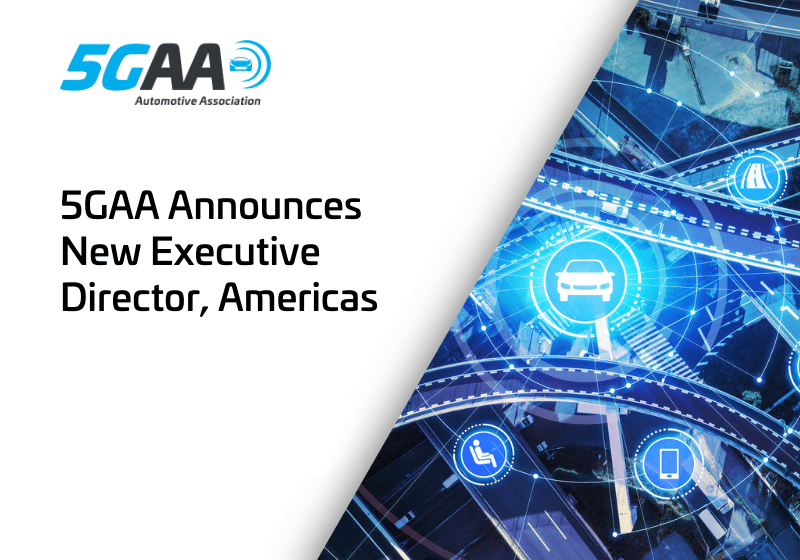
5GAA Announces New Executive Director, Americas
John F. Kwant will lead 5GAA’s U.S. activities as the trade association’s first Executive Director, Americas
Washington DC, March 28th – The 5G Automotive Association (5GAA) has announced the appointment of John F. Kwant as the organization’s inaugural Executive Director, Americas. In this new role, he will serve as the principal spokesperson for 5GAA in the United States while developing and executing a public policy and communications strategy to advance the safe and timely deployment of Cellular Vehicle-to-Everything (“C-V2X”) technology.
“John is a well-known and respected thought leader and advocate for connected technology deployment, so we are thrilled to have him lead 5GAA’s efforts to facilitate connected mobility in the United States. John’s appointment as Executive Director, Americas signals how far 5GAA has progressed in recent years, and the creation of this position is a natural next step in shaping the new era of mobility and paving the way towards connected driving,” said Christoph Voigt, chairman of the 5GAA Board. “His extensive advocacy experience and knowledge of the connected mobility landscape make him uniquely suited to navigate public policy issues, build relationships, and drive 5GAA’s message in the Americas.”

Prior to joining 5GAA, John spent more than 20 years with the Ford Motor Company, holding various global business, strategy, and government relations roles in Dearborn, Washington, D.C., and Shanghai. Most recently, he was Ford’s Global Director of Mobility and Advanced Technologies, leading global advocacy for autonomous and connected vehicles and mobility solutions. In this role, he was instrumental in establishing 5GAA’s U.S. Policy Taskforce, serving as its Chair for several years.
The National Highway Traffic Safety Administration (NHTSA) estimated that 42,915 people died in motor vehicle traffic crashes in 2021, a 10.5 percent increase from 2020. Many of these incidents could be avoided with the broad deployment of roadway safety technologies like C-V2X. NHTSA has previously estimated that safety applications enabled by V2X could eliminate or mitigate the severity of more than 80 percent of light vehicle crashes.
“With the right policies in place, C-V2X technology will deliver significant safety benefits and would likely help to reverse the rising number of roadway fatalities on our roadways. I believe we’re at an inflection point, with broad public and private sector consensus that now is the time to deploy,” said Kwant. “I am thrilled to be working with recognized leaders in the automotive, telecommunications, and technology industries towards broadscale deployment of C-V2X solutions.”
Kwant is a native Michigander with a Bachelor of Science in Engineering, Industrial and Operations Engineering from the University of Michigan. He also holds both a Master of Business Administration and a Master of Engineering Management degree from Northwestern University.
About 5GAA
The 5G Automotive Association (5GAA) is a global, cross-industry organization of over 130 members made of leading global automakers, Tier-1 suppliers, mobile operators, semiconductor companies, and test equipment vendors. It works together to develop end-to-end solutions for future mobility and transport services. 5GAA is committed to helping define and develop the next generation of connected mobility, automated vehicle, and intelligent transport solutions based on C-V2X. For more information, visit our website www.5gaa.org.

5GAA Connected and Automated Driving Workshop, Showcase and Demonstration Overview – 23 May 2019 – Berlin, Germany
The 5G Automotive Association (5GAA), a global, cross-industry organisation with over 115 members working together to develop end-to-end solutions for future mobility and transportation services, is pleased to invite you to the upcoming international workshop on “Connected and Automated Driving” in Berlin on May 23, 2019.
The workshop will gather EU and Member State policy makers from national and local levels, trade associations, 5GAA members and other industry representatives from the automotive and the telecommunications sectors.
The focus of the workshop will be on key issues of the global progress in the field of Connected, Cooperative and Automated Mobility and related challenges of cross-border automated driving, especially in Europe, and the current needs for connected mobility in both rural and urban mobility contexts.
In the afternoon, live demonstrations of C-V2X enabled connected cars, traffic infrastructure and other road users will take place on a fairground close to Tegel Airport (registration required), accompanied by a showcase of C-V2X technology that is ready to positively contribute to increase safety, especially for vulnerable road users, on roads across the world.
Due to limited capacity, the Workshop, Showcase and Demonstration is by invitation only to the groups mentioned above; if you are part of one of these groups please contact liaison@5gaa.org for more information.


